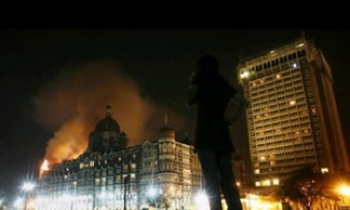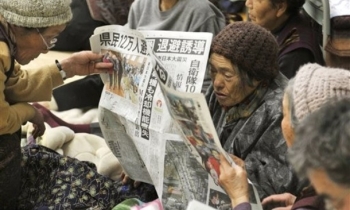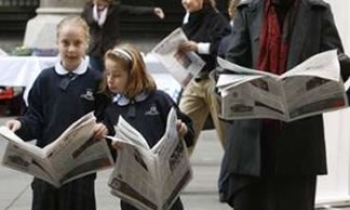IN August, Mumbai was not only flooded with rain, but also with newsprint. Two new English newspapers - Daily News and Analysis (DNA) and Hindustan Times (HT) hit the stands in a metropolis where The Times of India (TOI) has had a virtual monopoly. Suddenly, piles of newsprint are being dished out to readers, as newspapers compete with quantity as well as quality.
For months, DNA kept up an aggressive hoarding campaign, raising curiosity before its launch. Its promoters, the Dainik Bhaskar and Zee media groups, did a pre-launch survey of over 3 lakh households which increased anticipation and helped it lay the ground for its distribution network. Hindustan Times, on the other hand, has been more low key, but has tried to get loyal readers by offering annual subscriptions which amount to paying less than Re. 1 a day.
Why has Mumbai's lethargic newspaper industry suddenly become a `hot market' for new competitors? First, because it has the country's largest advertisement revenue of Rs.1,000 crores, of which only one player - The Times of India - has the lion's share. The new entrants are vying for a piece of the pie. The Times of India's advertising rates are the highest in the country. For long, advertisers have felt that they have been held to ransom as they have no choice but to pay exorbitant rates to The Times of India in order to reach Mumbai's upmarket consumers. Now, there are other platforms, but they will have to prove themselves before advertisers start considering them an option.
"Advertisers are happy that there will be competitors. But, there won't be a dramatic shift in ad spend in the short term. Only when any of these newspapers cross 50 per cent of The Times of India readership, will they claim a place in any advertiser's media plan," says Himanshu Shekhar, Investment Director of Mindshare Fulcrum, a leading media planning agency. At present, DNA and Hindustan Times' advertisement rates are around one-fourth that of The Times of India.
Both DNA and Hindustan Times are essentially competing for the No. 2 slot in the market. The Times of India is too old and established to be overthrown in the short term. With a six lakh circulation, it was far ahead of earlier competitors like Indian Express (58,000). In fact, it was The Economic Times (1.47 lakhs) and Mid-Day (1.40 lakhs) that trailed in second place after The Times of India in Mumbai. While there are varying estimates on how the new newspapers are doing, market sources estimate that DNA sells around two lakhs and Hindustan Times 1.40 lakhs. However, DNA claims that it is printing 2.90 lakh copies and Hindustan Times says it sells 2 lakh copies.
Though The Times of India claims that its circulation remains the same, a newspaper agent says that its counter sales have reduced by 40,000 to 50,000 copies. "It's probably because other newspapers are half the price, while the content is not very different. Moreover, people are curious about the new newspapers," he says.
Months before DNA and Hindustan Times launched in Mumbai, The Times of India went on the defensive and started a new `compact' newspaper, somewhat like a tabloid, called Mumbai Mirror. But it did not sell much, so The Times of India started distributing it free with the main newspaper. Now, for Rs.4, The Times of India reader gets more than 100 pages. "We always knew that there was space for a second newspaper in Mumbai, and so we started an alternative to broadsheets - a compact. By including Mumbai Mirror with The Times of India, we are improving the price performance ratio of our brand," says Bhaskar Das, executive president of The Times of India group. "The Mirror is a newspaper for the new generation who want news-on-the-go like McDonalds. It's for the supersonic age where people want to scan news without going into too much depth."
It is essentially a `blockading' strategy - you flood the reader with so much that he/she does not feel the need for another newspaper. "A normal reader spends 20-25 minutes on newspapers. Do you think he/she will spend more time reading just because there are new newspapers?" asks Das.
The Times of India readers are suddenly seeing a lot more news in a paper that once gave news a back seat to fluff. "The TOI has also taken a lot of rear guard action by beefing up its coverage. New competitors have raised the bar," says Das. Moreover, both The Times of India and Mirror went on a massive recruitment of journalists and media executives at high salaries, mopping up manpower and making it more expensive for their competitions to recruit. But advertisement rates are as expensive as ever, around four times that of DNA or Hindustan Times.
What seems inevitable, however, is that circulation will expand. "Around 40 per cent of Mumbai's population speak, read and write English, of which only 20 per cent are buying English newspapers," says Shekhar. As Girish Agarwal, Director of the Bhaskar group that owns DNA, points out, "We believe in widening the market, like we have in all the cities that we have launched newspapers and become the leader. Since the time we started Divya Bhaskar in Gujarat, readership there has increased by 49 per cent in two years and ad revenue also increased by 40 per cent."
"In the next few years, Mumbai's market will expand by up to 75 per cent, with even The Times of India growing," says Meenakshi Madhvani, Managing Partner of Spatial Access media solutions. "Delhi has a slightly lower population than Mumbai, but there are 12 lakh [copies of] English newspapers sold there as compared to only 7.5 lakhs [copies] in Mumbai. There will be dramatic market expansion in Mumbai. But ad spend won't keep up, since it is already oversaturated. Mumbai has the highest ad rates in the country."
Why has Mumbai's newspaper industry been stunted for so long? "The demand for newspapers is extremely price sensitive. Until now, The Times of India was way ahead of the competition. So, it had a high cover price and didn't push for greater sales, because that would increase their costs (since the cost of producing a newspaper is much greater than its market price). They didn't need to increase circulation, since they anyway milked all the ad revenue," says Madhvani.
THE new newspapers are priced much lower - Hindustan Times at Rs.2.50 and DNA at Rs.2 - which have boosted initial sales. "Generally, the price of an English newspaper in every city is around Rs.2, only Mumbai was an aberration where The Times of India was priced at Rs.4. However, now they have tried to increase their value proposition by adding a second free newspaper to The Times of India," says Sandip Ghose, Vice-President, Marketing, Hindustan Times. DNA's vice president, Sales, N.B. Verma, says: "We want as many people as possible to sample our product, so we have kept the price low."
The Bhaskar group, which has established several successful Hindi editions and the Gujarati Divya Bhaskar, has always followed the strategy of reaching out to readers through surveys, flooding the market, distributing freebies. Surprisingly, DNA's counter sales are giving the afternoon tabloid Mid-Day a run for its money. But, as a newspaper agent points out, a vendor stands to earn 45 paise more per copy if he sells DNA in the raddi (recycled paper) market, rather than selling it at the counter at Rs. 2.
So, are the new newspapers really offering the reader anything different? Hindustan Times says it is targeting the `discerning' reader who wants more than `regurgitated headlines' and page 3. "We are trying to engage people in a dialogue, and create a product that is uniquely Mumbai. Hindustan Times takes up Mumbai's issues without dumbing down the content or making it tabloidish," says Ghose. With fewer pages than its competitors, Hindustan Times' layout, more classical and less cluttered, does look different.
DNA, with different business, sports and lifestyle sections, says it is trying to make newspapers more accessible to readers. "Ours is a family newspaper that offers value for money. In our paper, we clearly differentiate fact from fluff. Readers want both, but they are not mixed together. We have recruited the best journalists for our team," says Agarwal. "We have a lot of city news which reach out to the younger but informed audience. In fact, we even have a page called `Speak Out' where readers can write in," says Gautam Adhikari, editor of DNA.
The Indian Express is emphasising its USP - `Journalism of Courage'. As part of a campaign called "India Explained, India Empowered", it has got several prominent leaders including the President, Prime Minister, former Prime Ministers and film actor Shah Rukh Khan to write columns on the front page describing their idea of an `empowered' India.
The Times of India, while maintaining some of its fluff, has become far more news-oriented and also more colourful. "Our newspaper is aimed at empowering the reader. We are not into crusading or agenda journalism, but are still doing investigative stories on issues that matter in our reader's life," says Das. "With all the new newspapers coming in, the reader is the ultimate winner because everyone is splurging to gain his/her attention."
But is it merely a Hobson's choice? As Charudatt Dangat, Mumbai's largest newspaper agent, put it, "What choice does the reader really have? It's more in terms of price. Most of the stories in all of the newspapers are the same. The journalists keep shifting, from The Times of India to DNA and back again." Another industry insider added, "Even though the readers want better content, unfortunately, the competition is taking place on the marketing and sales front, rather than the editorial."









